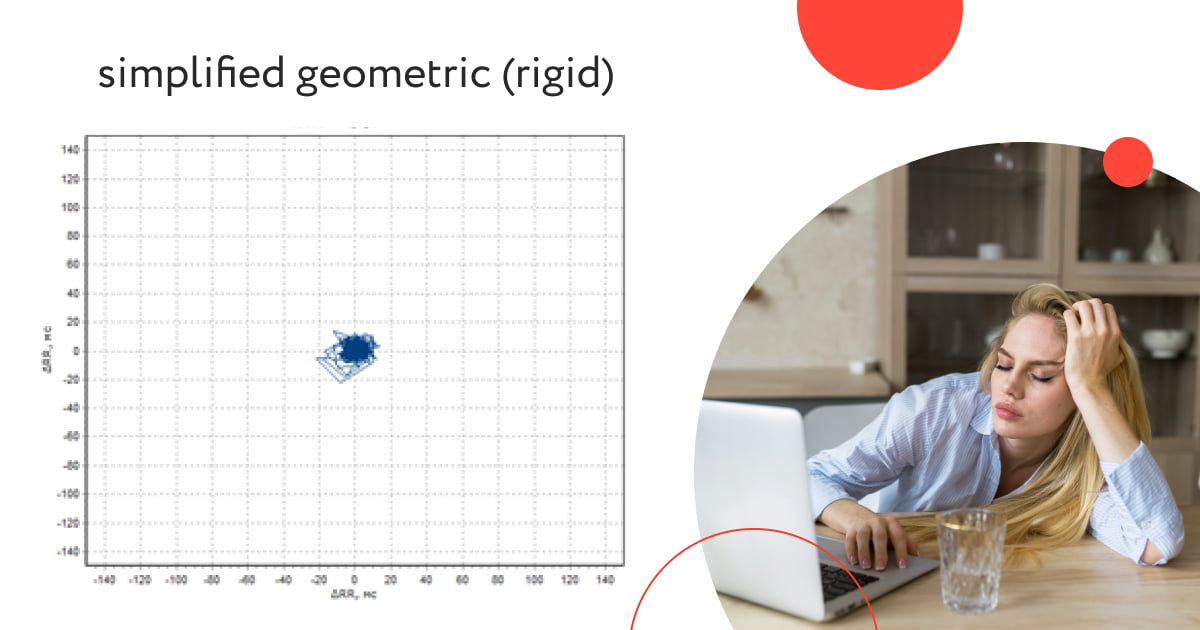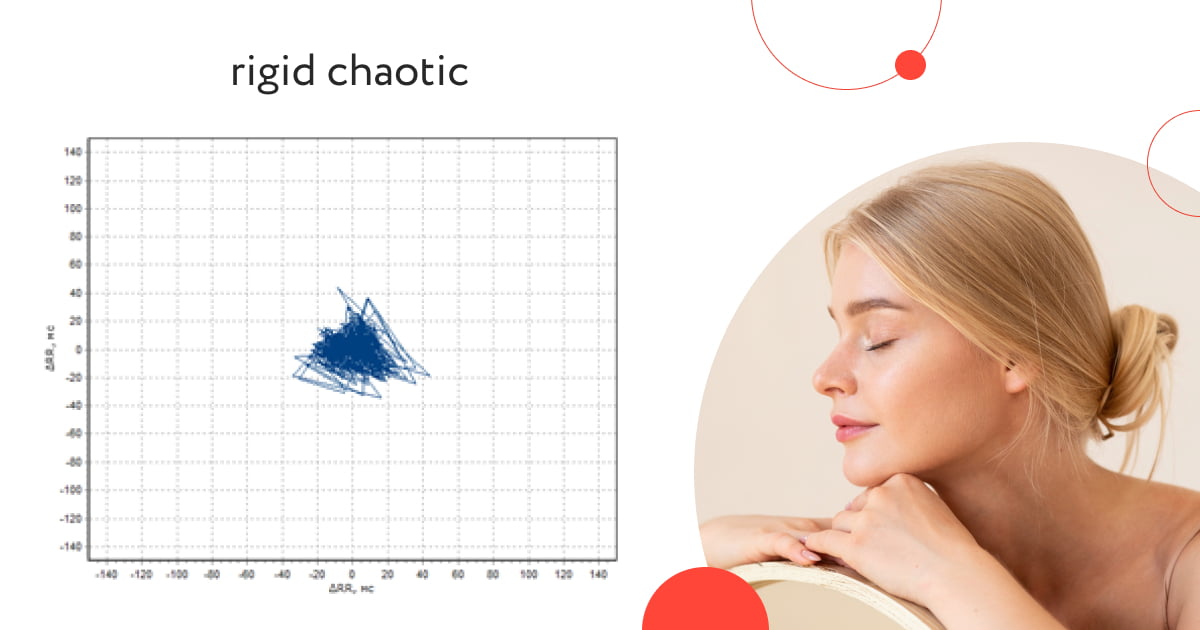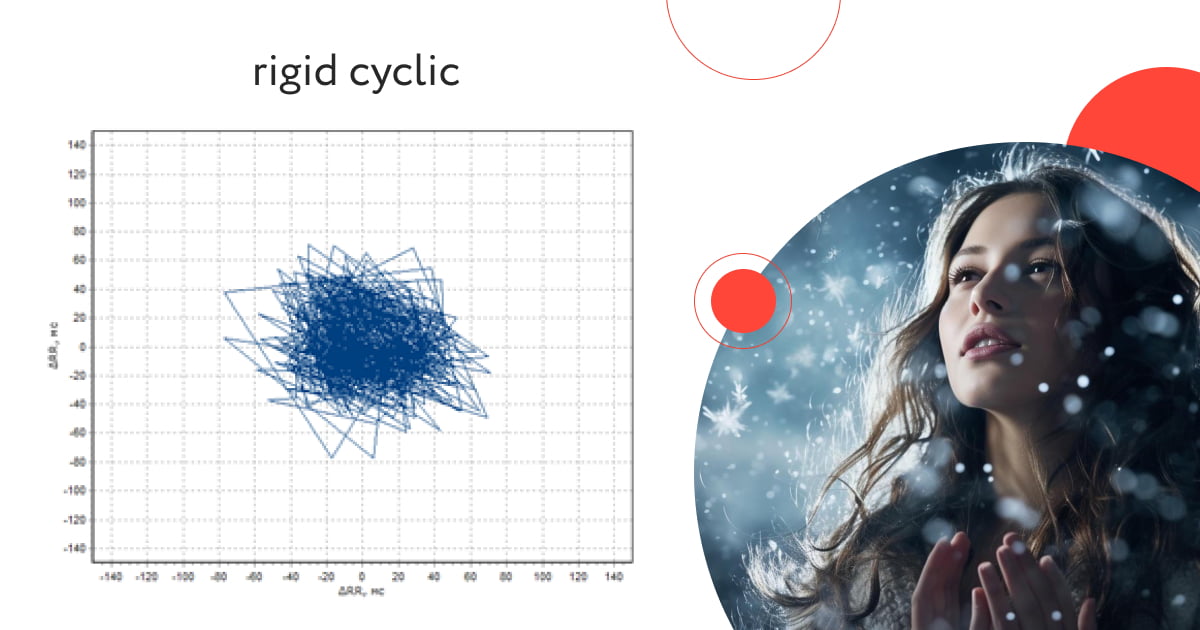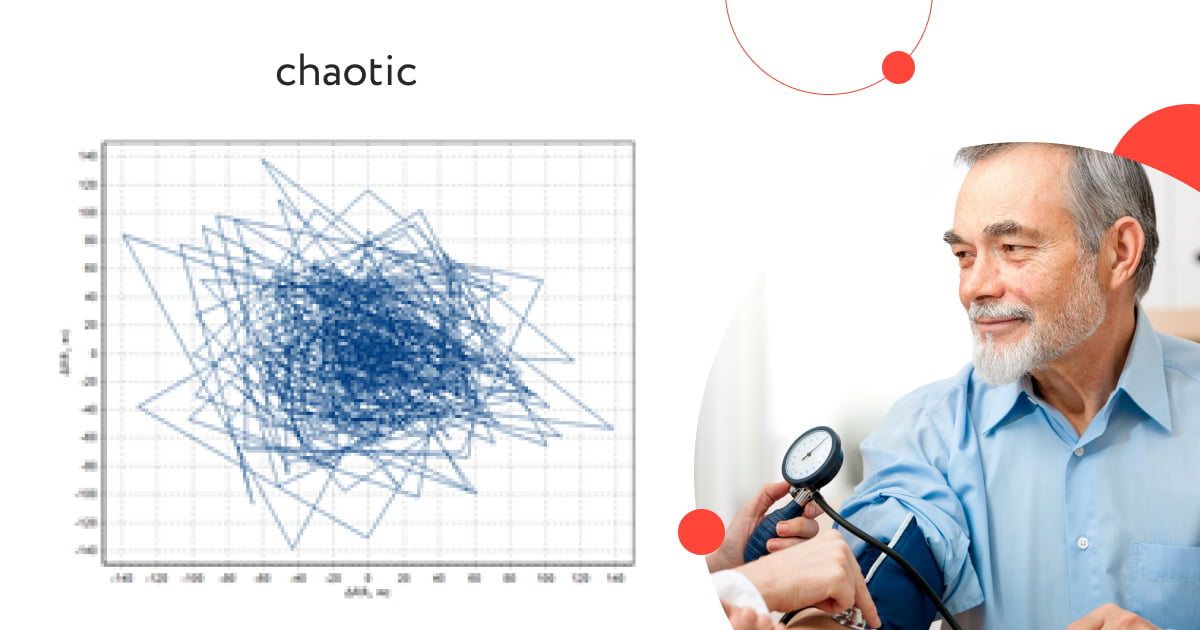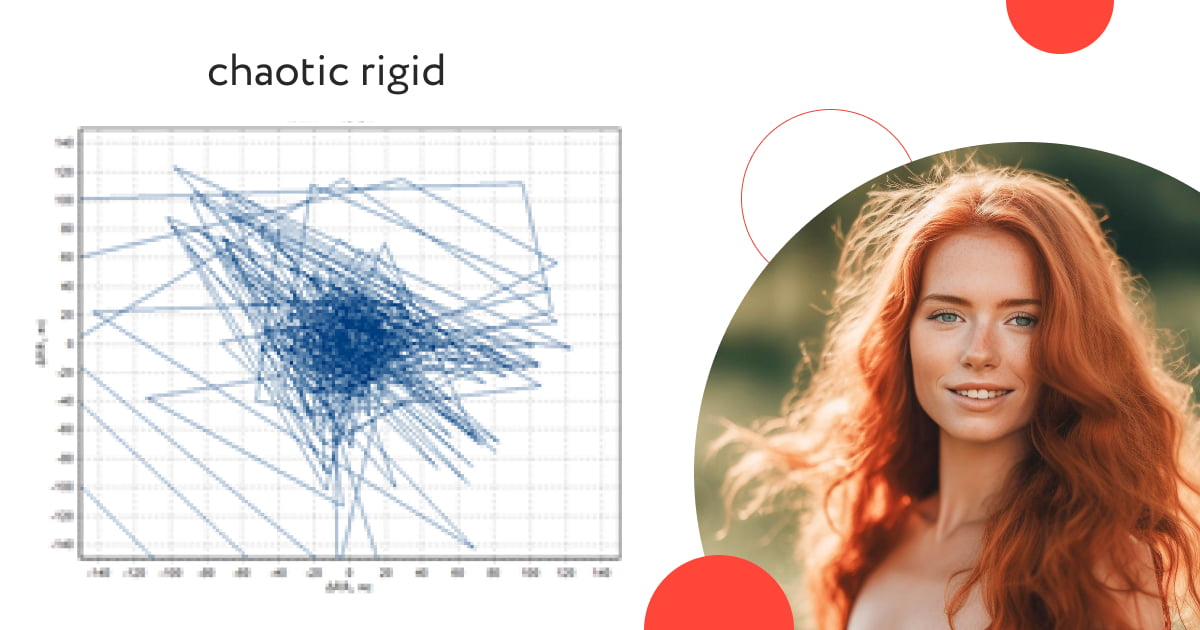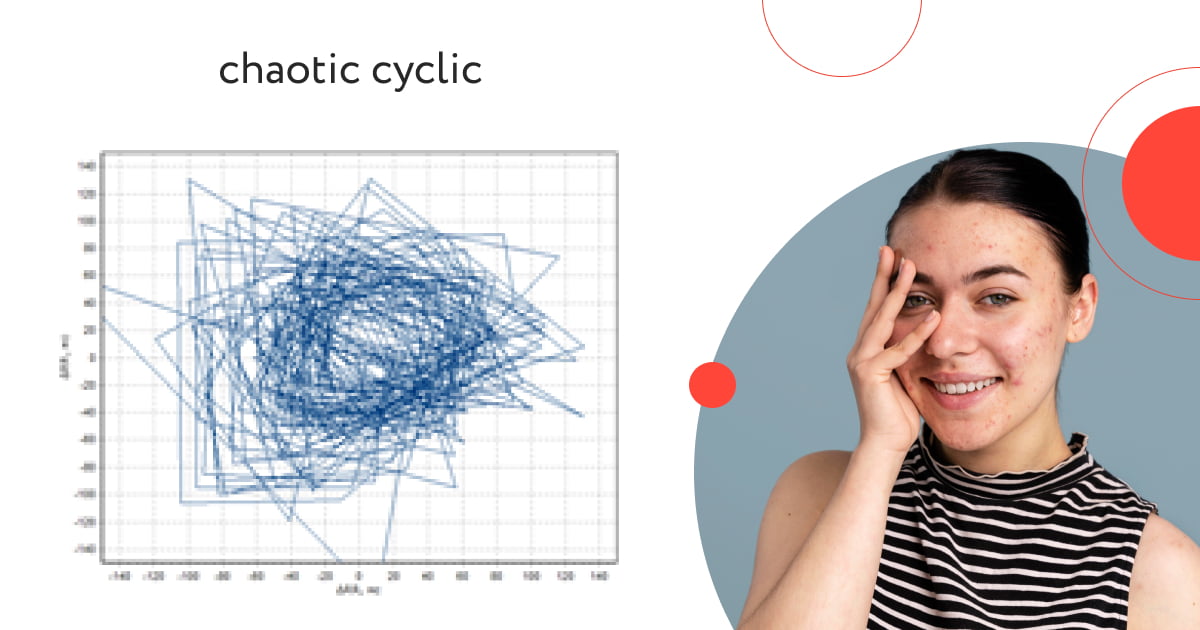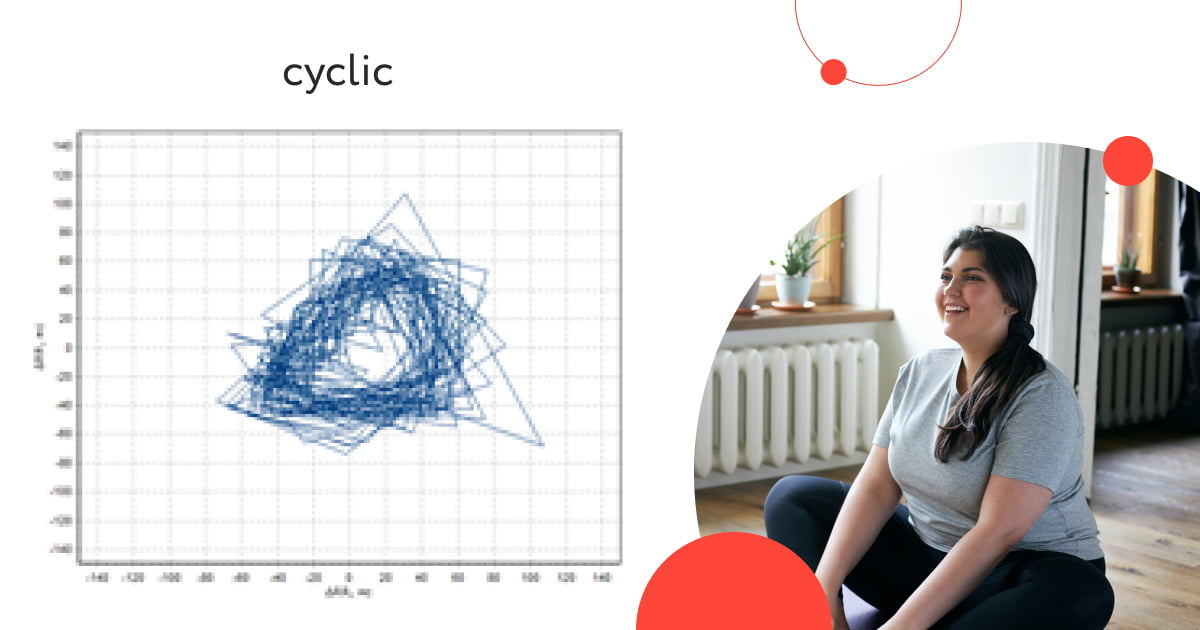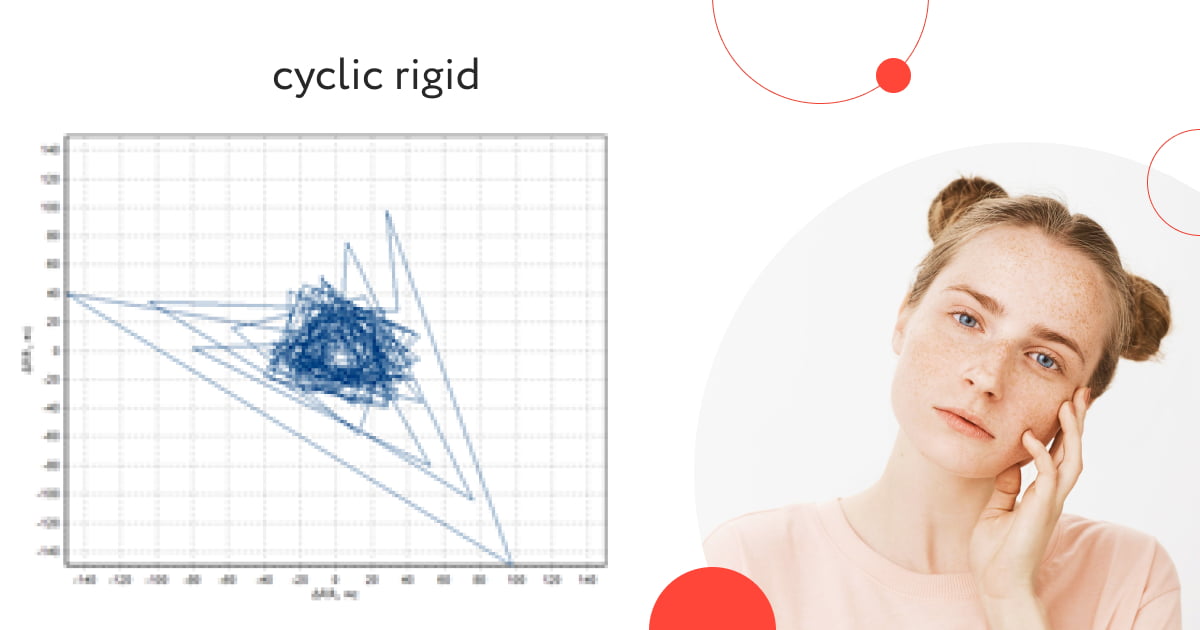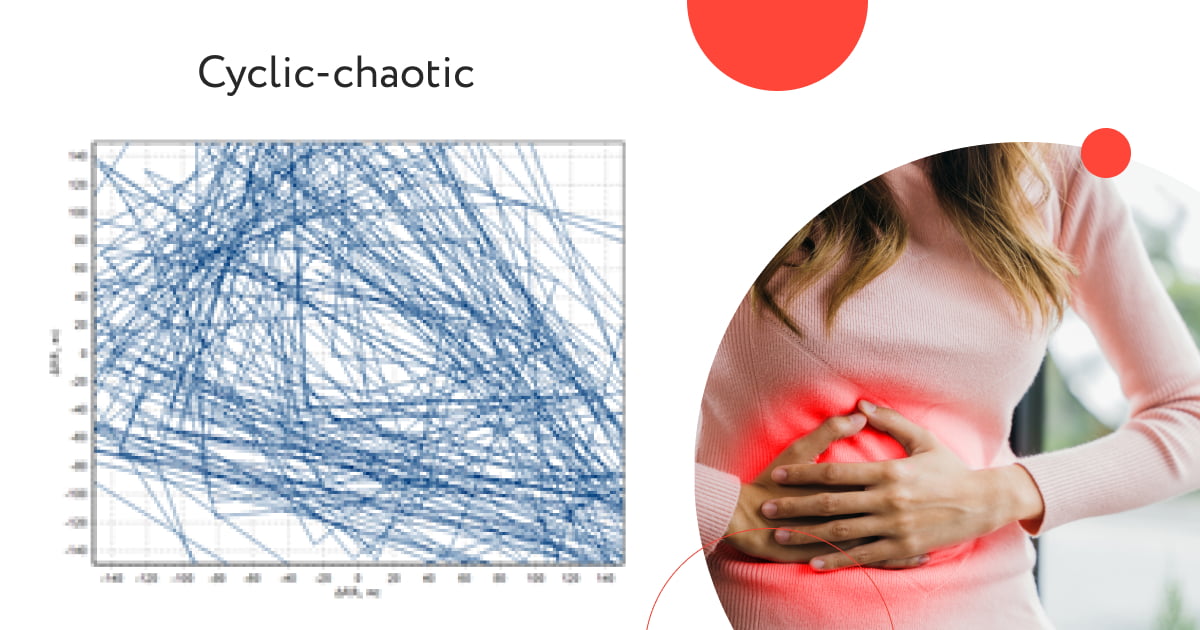This article is the first in a series of publications in which we will tell you more about the functionality of the new Nonlinear Dynamics software module. This module allows you to apply algorithms of mathematical analysis of the heart rate to assess the most subtle changes, which is particularly important for researchers, scientists and clinicians who need an objective assessment of the impact of various external factors on the body. At the moment, the first attempts are being made to study the non-linear dynamics of the heart rate, the scientific community has not developed universal criteria and methods of applying mathematical analysis data to evaluate non-linear dynamic systems.
Today we are going to introduce you to the first part of the software module "Phase Portrait/Dynamic Chaosogram" and we are going to make a correlation between constitutional types from the Ayurvedic point of view and the types of chaosograms specific to them.
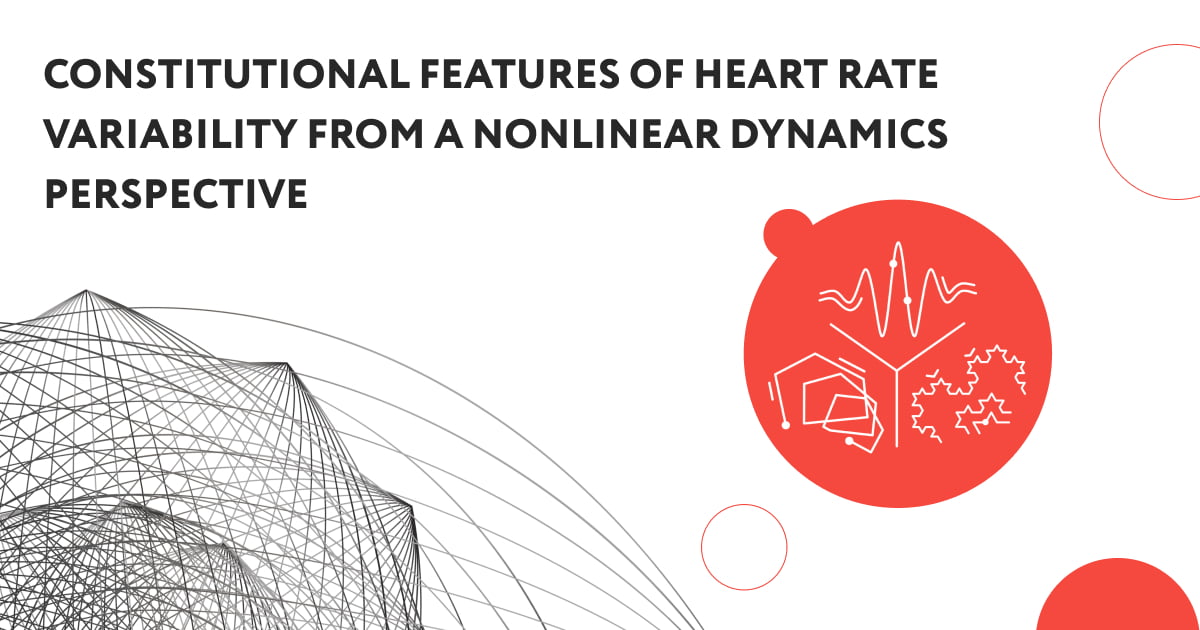
A chaosogram is a geometry of points in the phase plane whose coordinates are increments of neighboring cardiointervals. When analyzing the assessment data, it is advisable to pay attention to the shape, structure, geometry, size of the chaosogram and the presence of free-standing cycles.
Within the framework of the classification study, typical representatives of various constitutional types according to Ayurveda were selected from a group of test persons, and during the examination of the test persons using the VedaPulse system, it was possible to identify the signs observed in most cases and to draw the following conclusions.
A healthy person is characterized by stable ellipsoidal cycles with a single point of attraction and a spidery appearance of chaosograms. Depending on the characteristics of the constitution type, the graphs will be more cyclical or more chaotic. Determinism (cyclicity) is associated with complete and unambiguous predictability, whereas chaos is associated with unpredictability and non-reproducibility.
The chaosogram also revealed tendencies associated with Vata, Pitta and Kapha constitutions. A typical characteristic for Vata dosha is rigidity (simplified geometric shape), for Pitta - vastness and randomness, for Kapha - pronounced cyclicity.
Let's look at the examples of a chaosogram common to each type of constitution.
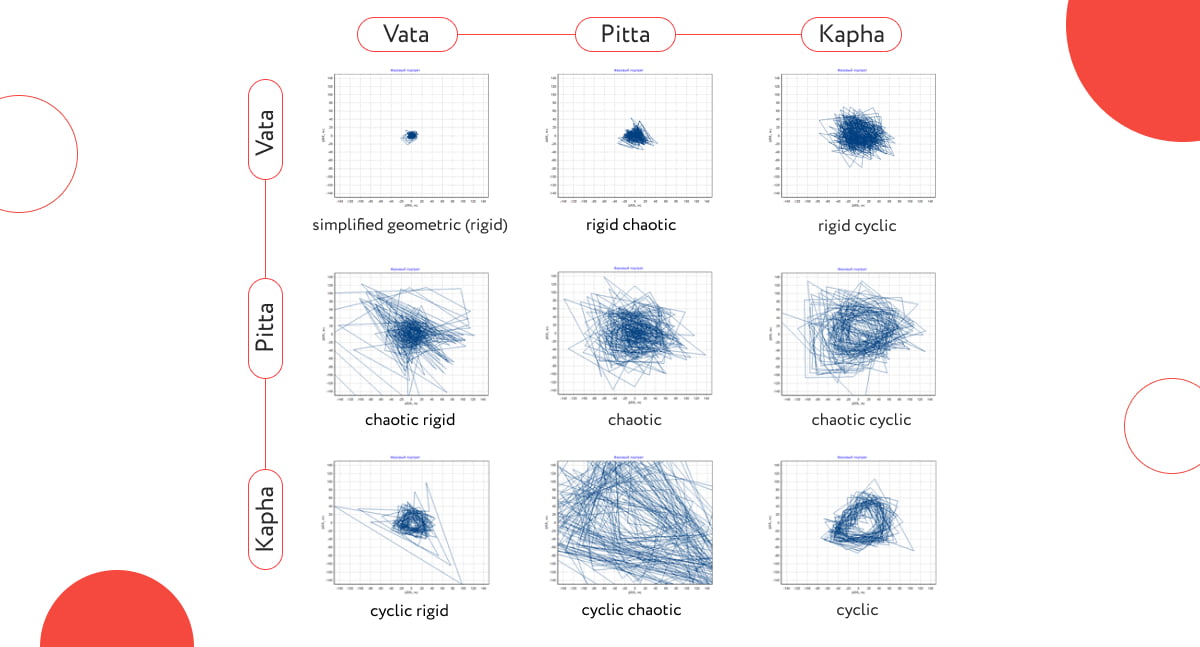
Vata types
Vata type — the tendency to structural and geometric simplification is manifested on the chaosogram — the intervals differ little from each other. This is due to the peculiarities of the vata type — asthenia, low reserve of vital forces (the total power index is below 100 CU, with the normal range within 1500 to 3000 CU), as a result of which the functional activity of internal organs and the whole-body decreases.
In TCM, this type corresponds to the syndrome of qi deficiency (emptiness) - a complex of constitutional features developed due to a deficiency of primordial energy qi (Ojas) and manifested by a decrease in the function of internal organs, respiratory weakness (saturation with Prana), a decrease in human vital activity, in which a lack of vitality leads to a decrease in the functional activity of internal organs and the whole organism in general. There is muscle weakness, tachycardia, fatigue, lethargic and depressed mood, profuse sweating, yellowish or pale complexion, lack of lustre in the eyes, isolation, emotional instability. The general weakness of the protective forces provokes frequent colds, a tendency to visceroptosis (loss of internal organs), general exhaustion, etc. With constitutional emptiness of qi energy (ojas), long-term, chronic, recurrent diseases often manifest (acute course of diseases is not characteristic of this constitutional type), frequent colds with weak temperature reaction, ptosis of internal organs, autoimmune diseases, oncological alertness.
Dual Vata-Pitta type — Pitta type waves are added to the chaosogram — more energy appears, the chaosogram increases but retains a geometric appearance, chaotic fluctuations. There are sharp changes in the direction of the interval increment vector - the rate of change of the interval duration. The reserve of vitality is higher compared to the Vata type, but still below the regulatory corridor. People of the Vata-Pitta type are characterized by a tendency to pallor and thinness. This type of constitution is common among young people who are mainly engaged in mental work, and one of the basic recommendations for maintaining Vata-Pitta type health is to avoid heavy food, smoking and alcohol abuse.
In TCM, this type corresponds to the syndrome of blood deficiency (emptiness). Typical signs of this syndrome include pallor, atrophy, thinned "parchment" skin with a yellowish tinge, dry mouth, lack of saliva and body fluids, dizziness with changes in weather, insomnia (especially in the second half of the night), memory problems, early appearance of wrinkles, dry stools, hasty unintelligible speech, confusion of thoughts, difficulty in focusing attention.
This type is at risk for diseases such as atopic and dystrophic dry dermatitis, blood damage as a result of physical and mental overload. There is a tendency to develop latent iron deficiency, anemic and sideropenic syndromes, dry eye syndrome, menstrual cycle disorders and infertility in women, early greying and baldness in men are possible.
Vata-Kapha — the destruction of structure occurs, deterministic chaos manifests itself. The intervals become more distinguishable, we fix the expansion on the graph, but the "window" type characteristic of pure Kapha in the center of the chaosogram has not yet appeared.
Switching from the language of mathematical analysis to the imagery language, the "window" at the center of the chaosogram can be compared to the "eye of a hurricane". Eye of a hurricane or eye of a storm - this is the name given to the area of clear and relatively calm weather in the center of a hurricane, tropical cyclone or typhoon. It is thought that this hurricane center contains information about what is happening inside the cyclone at that moment. The "window" of the chaosogram is a window of possibilities, the vital energy of the subject, whose centrifugal force orders the chaos.
From a constitutional point of view, this type combines the characteristics of Vata and Kapha doshas: fear of cold, often inseparable from joint pain, intolerance to cold, hypersensitivity to humidity and wetness, digestive disorders, obesity, weak muscle tone. The reserve of vital forces is usually sufficient (the lower limit of the normal range).
In TCM, this constitutional type corresponds to the Yang Deficiency (Emptiness) Syndrome — a complex of constitutional features developed due to a deficiency of Yang origin (low Agni) and manifested by a decrease in physiological activity and a violation of the warming of internal organs and tissues, the formation of Empty Cold signs.
This type often affects middle-aged men and young women and is characterized by: shivering, cooling of the limbs, slow pulse, pale face, dark circles under the eyes, pale lips, hair loss, excessive sweating, profuse urination, unformed stools. People with manifest Deficiency Syndrome (Emptiness) Yang are often in a bad mood, very impressionable, prone to fits of rage. They are characterized by long-term, chronic illnesses with pronounced characteristics of weakness (emptiness) and cold, reproductive dysfunction (infertility/impotence), digestive disorders (Vishama-Manda Agni), food sensitivities (lactase and gluten intolerance), atopy — allergic rhinitis, bronchial asthma, skin diseases.
Pitta types
Pitta is a chaotic type of chaosogram of a large area — this constitution type is characterized by the highest level of vitality (the values of the Total Power Index are above 3000 units). Most people of Pitta type have a strong physique, increased motor and speech activity, excessive appetite. Pitta type people do not tolerate heat well, often show short temper, anxiety.
In TCM, this constitutional type corresponds to the Yang Excess Syndrome (stagnant heat) – a complex of constitutional features that develop due to an excess of Yang energy with the formation of signs of Full Heat Syndrome, manifested by functional hyperactivity and excessive Heat production. Typical signs of this Syndrome are a red face, red lips, acne, a hot body and limbs, a strong physique, ulcers and erosions in the mouth and tongue, a sonorous loud voice. There may be dry mouth, ulcers and erosions in the mouth and tongue (aphthous stomatitis), bad breath, cystitis, dry stools. Diseases of this type are manifested by symptoms of a Complete hot syndrome with a triad of signs: fever (hyperergic nature of reactions), redness and cloudy, yellow discharge. Representatives of this type are at risk for diseases such as mute killer-hypertension, which leads to heart attack and stroke, acne (the rise of pathogenic fire up), dysphoria.
Pitta-Vata is a chaotic rigid chaosogram, the rigidity characteristic of the Vata type is preserved, at the same time, the scope characteristic of the Pitta type appears. The chaosogram preserves a rigid core, individual "outliers" can be observed on the graph due to the Pitta factor. From the point of view of Ayurveda, Pitta-Vata type is characterized by a tendency to thinness, lack of fluids in the body, haste and increased excitability, in order to maintain health, it is necessary to consciously control emotions, eat less dry, spicy and hot foods, limit sexual activity if possible.
In TCM this constitutional type corresponds to the Yin Deficiency (Emptiness) Syndrome. Characteristic of this constitutional type is haste and increased excitability, flushing, a feeling of heat in the body, dry eyes, reddish dry lips, dry skin, early appearance of wrinkles are the external signs. Such people may also complain of blurred vision, dizziness, ringing in the ears and poor sleep. Their illness is long and chronic, with an obligatory quartet of symptoms: weight loss, dryness, fever, exhaustion — asthenia. Dryness of the mucous membranes of the gastrointestinal tract, the urinary tract, the reproductive system, the bronchopulmonary system, a tendency to skin diseases with dry skin are typical of this syndrome. "Empty fire" disturbs the spirit of the heart, cardiac arrhythmias, and at a more mature age "burns" the body of a woman and a man, provoking a pathological course of menopause.
Pitta-Kapha is a chaotic cyclic type of chaosogram with sufficient range. The reserve of vital forces is usually within the normal range. The 'window' of the chaosogram is not clean, but is filled with manifestations of Pitta type chaos. Pitta-Kapha people are often overweight or excessively thin, have various skin rashes, increased sweating, reddened eyes, increased moisture in the scrotum in men, abundant vaginal discharge in women.
In TCM, this type of constitution corresponds to the Damp Heat Syndrome. People with the manifestation of Damp Heat Syndrome can hardly tolerate a hot and humid climate, suffer from pathologies such as boils, jaundice (heat and fire syndromes). Behaviorally, they show anxiety, irritability, frequent outbursts of anger, are prone to laziness.
Kapha types
Kapha is a cyclic type of chaosogram. We observe simple cycles of deterministic chaos, maximum order, stability. The level of vitality is within normal limits. Kapha type people are characterized by obesity, accumulation of adipose tissue in the abdomen, reduced muscle elasticity, soft, reserved character, reasonableness, patience.
In TCM, this constitutional type corresponds to the Excessive Dampness Syndrome — a complex of constitutional features that develop due to the stagnation of body fluids in the human body (primary stagnation of qi energy), their thickening (metabolic transformation of intercellular matrix gel) and condensation (accumulation of mucus in organs and lipogenesis) with the formation of pathological dampness and sputum with turbidity properties (hyperlipidemia) and viscosity (clearance and immune disorders).
People with Excessive Dampness Syndrome can be recognized by a dull, yellowish face and swollen eyelids. There may be complaints of fatigue, a feeling of heaviness in the body. Patients of this type are at risk in connection with diabetes mellitus, apoplexy (cerebrovascular insufficiency), angina pectoris, tumors, etc. They are characterized by the development of diseases associated with the retention of cloudy pathological fluids against the background of excess body weight and "loose" (pasty) physique: bronchopulmonary diseases with cough and sputum, obesity.
Kapha-Vata is a cyclic rigid type of chaosogram. A "window" begins to appear in the center of a rather rigid chaosogram, indicating a tendency towards cyclicity, with occasional chaotic "outliers". Low vitality. This type of constitution is characterized by weakness, melancholy, characteristic pathologies - depression, insomnia, functional diseases of the nervous system.
In TCM, this constitutional type corresponds to the qi stagnation syndrome — a complex of constitutional features that develop as a result of a disruption of the "energy mechanism - qi ji" and are manifested by circulatory disorders in the lymphatic system, emotional disturbances and energy stagnation (violation of redox processes in tissues, with the accumulation of metabolic toxins). In their behavior such people show isolation, depression, hypersensitivity, suspicion. They can be recognized by a sad expression on their face, they are prone to melancholy, despondency. They may complain of pain in the hypochondrium, hiccups, a feeling of a "lump" in the throat, chest pain, forgetfulness and poor sleep. Stagnation of energy leads to "obstructive diseases", as the liver supports the circulation of in qi/Prana according to TCM, the severity of the syndrome depends on the degree of its dysfunction. Typical diseases and disorders with this syndrome are PMS and menstrual delay, biliary dyskinesia, chronic internal anxiety and depression, addictive tendencies, tumors.
Kapha-Pitta is a cyclic-chaotic type of chaosogram. The "window" is weakly expressed, as in the case of the Pitta-Kapha type, but the range is the greatest. There is stagnation of energy, chaotic attempts to create a semblance of order. Kapha-Pitta people are prone to frequent depression, so it is advisable to get rid of a bad mood in time. Most suffer from weight loss, anxiety and forgetfulness.
In TCM Kapha-Pitta type correlates with Blood Stagnation Syndrome — a complex of constitutional features that develop as a result of the slowing of the movement (stagnation) of the blood, manifested by circulatory disorders and energy stagnation. Typical external signs of this syndrome are a dark face with an abundance of brown spots (pigment deposits), purple lips, dilated skin veins, bruising, dark circles under the eyes, dark nose, hair loss, dry skin, bruising on the body. There may be a feeling of tightness in the chest, shortness of breath, chest and heart pain, hemoptysis (bloody vomiting), women often suffer from dysmenorrhea with the presence of blood clots during menstruation or amenorrhea, metrorrhagia. Typical diseases associated with this syndrome include hemorrhage, apoplexy, gynecological diseases (with the formation of seals in the pelvic cavity, with pain, swelling, bleeding in the lower abdomen).
Tridosha type
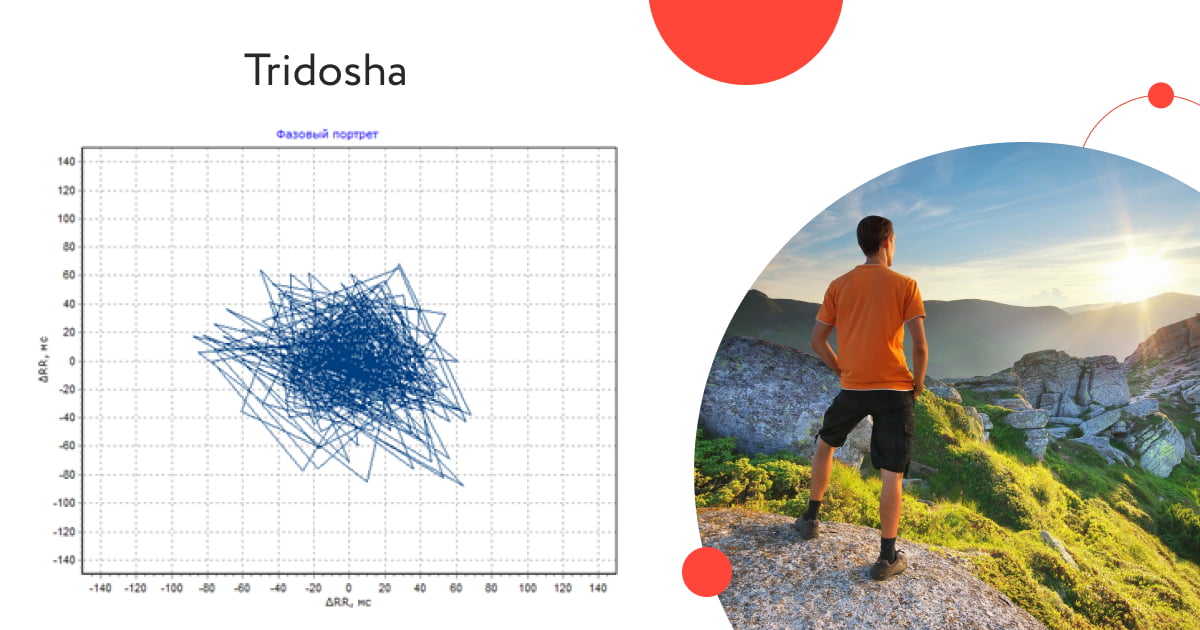
A chaotic type of chaosogram is commonly present, with a sufficiently large area without separate emissions, which is the result of the superposition of three types of waves. The cyclicity of Kapha and the range of Pitta are balanced by the rigidity of Vata waves. Representatives of this constitutional type have a normal level of vital energy. They are characterized by a slight decrease in the level of vital energy, good natural data, normal physique, healthy complexion, vivacity, balance, internal organ functions are normal, friendly and open nature, calm and peace, patience.
Thus, the heart rate chaosogram has a pronounced tendency towards uniqueness for each constitutional type, which allows us to form additional algorithms for assessing Vikriti and Prakriti, as well as TCM syndromes by cardiointervalography.
Learn more about the Temporal analysis indicators on the Academic software module webpage.
